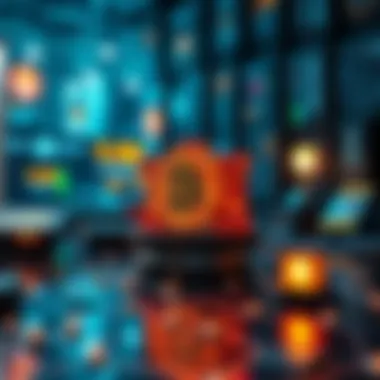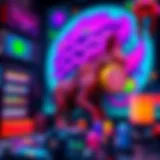Core Elements of NFTs Explained: Origins and Impact


Intro
In the ever-evolving landscape of digital assets, non-fungible tokens (NFTs) have emerged as a game-changer, captivating attention across industries. The unique attributes of NFTs, which set them apart from traditional cryptocurrencies like Bitcoin, lie in their ability to establish provenance and ownership of digital items. This first part will set the stage for an in-depth examination of NFTs by delving into their market trends and the technological innovations that underpin their existence.
Market Trends and Analysis
Understanding the market dynamics surrounding NFTs is crucial for anyone interested in leveraging their potential. Over the past few years, the uptick in interest has led to an explosion in the NFT marketplace, attracting a broad range of participants—from artists and gamers to investors and collectors.
Current Market Overview
As of late 2023, the NFT market is marked by a growing variety of applications. Major sales often grab headlines, influencing public perception significantly. Current platforms like OpenSea and Rarible showcase millions of NFTs spanning artwork, music, domain names, and virtual real estate. Despite fluctuations in pricing and interest, one cannot overlook the impact NFTs have on engaging users in new, innovative ways.
"The NFT market is not just a trend; it’s a shift in how we perceive ownership and value in the digital world."
Key Influencers Affecting Prices
Price movements in the an NFT marketplace can often seem erratic, driven by factors that can be difficult to predict. Here are some key influencers:
- Celebrity Endorsements: When high-profile individuals or brands drop NFTs, it can lead to a surge in interest and value.
- Cultural Events: Major events or shifts in societal perspectives can influence what artworks or collectibles are sought after.
- Technological Advances: As platforms and blockchain technology improve, it can lower costs and enhance user experiences, inviting more entrants into the space.
Technology and Innovation
The backbone of NFTs is fundamentally tied to their technological framework. Understanding the innovations that power them is essential for grasping their significance in the digital economy.
Breakthroughs in Blockchain Technology
At its core, NFT technology is grounded in blockchain, specifically Ethereum, which provides the infrastructure for recording ownership and transfer of these tokens. Innovations in blockchain have focused on enhancing scalability, security, and transaction speed. Projects designed for NFT minting are continuously evolving to create a more seamless experience for users.
The Role of Smart Contracts
Smart contracts act as the digital agreements that drive transactions for NFTs. They dictate ownership transfers and can be programmed for royalties and other conditions that benefit creators long after the initial sale. This capability ensures that artists and developers can reap ongoing benefits from their work, fundamentally changing how we view copyright and intellectual property in the digital realm.
In summary, NFTs represent an intricate interplay between market fluctuations and groundbreaking technology. Their rise demands a nuanced understanding of evolving trends, underlying tech, and the broader implications on ownership and value. This exploration will further dissect the intricacies of NFTs, offering investors, analysts, entrepreneurs, and developers deeper insights into their potential.
Prologue to Non-Fungible Tokens
The increasing buzz around non-fungible tokens, or NFTs, speaks volumes about their growing significance in the digital landscape. As more investors and creators explore this complex realm, understanding the foundational concepts of NFTs becomes paramount. This section will tackle the essence of what NFTs are and highlight their role in the wider expanse of digital assets.
Definition of NFTs
Non-fungible tokens are distinctive units of data stored on a blockchain, where each token represents ownership of a unique item or piece of information. Unlike cryptocurrencies, which are interchangeable and uniform, NFTs carry individual attributes. This uniqueness is what sets them apart. For instance, while one Bitcoin is just like another, each NFT could signify various forms of digital art, music, or even virtual real estate.
Historical Context
The journey of non-fungible tokens can be traced back to the early 2010s. Initially, experiments with tokens began gaining traction, signaling the onset of unique digital items. The launch of CryptoKitties in 2017 marked a turning point, introducing the concept of breedable and collectible cats as NFTs. These digital felines showcased the potential for blockchain technology to offer something beyond mere currency. As the NFT space evolved, various applications emerged, from art to gaming, paving the way for the industry's current trajectory.
Key Characteristics
While there are several components that define NFTs, three primary characteristics stand out: uniqueness, indivisibility, and ownership verification.
Uniqueness
Uniqueness refers to the distinct nature of each non-fungible token. Each NFT possesses unique metadata that distinguishes it from others, providing a level of authenticity and scarcity. This uniqueness is crucial for creators and collectors, as it imbues digital assets with a sense of value that cannot be replicated. Many artists, like Beeple, have embraced this aspect to establish their works' rarity, often leading to staggering sales.
Indivisibility
Indivisibility denotes that NFTs cannot be broken down into smaller units for sale; they exist as whole items. This characteristic enhances their appeal to collectors, as owning a complete piece offers a sense of integrity. For instance, a digital artwork priced at $100 cannot be subdivided into $10 shares, unlike cryptocurrencies. This aspect can enhance value perception since the asset retains its entirety, leading to specific marketing and sales strategies among creators and platforms alike.
Ownership Verification
Ownership verification is one of the most compelling features of NFTs. It allows creators to prove ownership and originality through blockchain technology, where each transaction is permanently recorded. This capability significantly curbs piracy and forgery, ensuring that buyers can trust the provenance of their acquisitions. In industries like art, this verification process is essential as it provides a level of security and confidence that encourages more substantial investments.
"The blockchain is like a digital ledger that records every transaction in a transparent and secure manner, ensuring the authenticity of every NFT."
In wrapping up this section, the exploration of NFTs reveals underlying components that define their identity and functionality in the modern digital ecosystem. As this landscape evolves, the understanding of these core components is vital for both investors and creators looking to navigate the complexities of this innovative field.
For further reading on NFTs, you might want to check Wikipedia or Britannica. Also, consider engaging with online communities such as Reddit to stay updated on the latest trends and discussions around NFTs.
How NFTs Work


Understanding how NFTs function is crucial for grasping their significance in the digital landscape. NFTs as digital assets rely heavily on innovative technology, making their operational mechanics pivotal to both creators and collectors. The mechanisms that underpin NFTs not only facilitate the creation and transfer of ownership but also contribute to their unique value propositions across various industries.
Blockchain Technology
Decentralization
One of the cornerstone features of blockchain technology is decentralization. This principle ensures that no single entity has control over the entire system, fostering trust and security among users. In the context of NFTs, decentralization is crucial as it allows artists and buyers to interact directly without intermediaries such as galleries or auction houses influencing the process. This key characteristic strengthens the overall ecosystem of NFTs because it minimizes the risk of fraud.
The unique feature of decentralization lies in its ability to preserve the authenticity and provenance of the tokens. For instance, once an NFT is minted and recorded on the blockchain, its history becomes part of an immutable ledger. However, this also poses some challenges, such as the difficulty in regulating certain transactions, which may lead to legal grey areas for creators and collectors alike.
Smart Contracts
Smart contracts are another vital component of how NFTs operate. These self-executing contracts are automatically enforced when predetermined conditions are met. The beauty of smart contracts is that they eliminate the need for intermediaries, streamlining transactions between parties. This feature is particularly advantageous in the NFT space because it allows for automatic royalty payments to artists every time their work is resold.
A key characteristic of smart contracts is their programmability; developers can customize them to meet specific needs, enhancing the utility of NFTs. Furthermore, this unique feature can also introduce complexities like bugs or vulnerabilities in the code, which may expose users to risks. Nevertheless, the overall benefits of transparency and automation far outweigh potential drawbacks.
Minting NFTs
Minting refers to the process of creating a non-fungible token and is often the first step for artists and creators in the digital asset realm. When an artist mints an NFT, they are essentially registering their creation on the blockchain, thus assigning a unique digital certificate to it. This process entails uploading the digital file—be it artwork, music, or a collectible—and filling in metadata to specify details like ownership and provenance.
The art of minting not only bridges the gap between creators and collectors but also influences the pricing and demand for the NFT in the marketplace. However, the costs associated with minting—including gas fees for blockchain transactions—can often be a deterrent for newcomers.
Transaction Mechanics
Once an NFT is minted, its journey in the marketplace begins. Transaction mechanics play a significant role in determining how these assets change hands. Typically, buyer and seller engagements occur through NFT marketplaces, which serve as platforms for listing, buying, and selling these tokens.
The key components of transaction mechanics include the bid and ask prices, which reflect market demand and the inherent value attributed to the NFT.
Here's a basic outline of the transaction flow:
- Listing: The seller lists the NFT on a marketplace, setting a price or accepting bids.
- Buying: A interested buyer can purchase the NFT directly or place a bid if it’s auction-style.
- Verification: Upon transaction completion, the blockchain verifies the transfer of ownership.
- Transfer: Ownership is updated, and the new owner receives the NFT in their digital wallet.
Applications of NFTs
The applications of non-fungible tokens (NFTs) span a broad spectrum of industries and creative expressions, signaling a shift in how we view ownership in the digital realm. In this section, we will dissect various notable applications of NFTs, highlighting their significance, benefits, and the considerations that come with their adoption across diverse fields. These applications underscore not only the versatility of NFTs but also their potential to redefine many aspects of art, gaming, collectibles, and beyond.
Digital Art
Artists and Marketplaces
Digital artists are finding themselves at the forefront of a revolution, thanks to NFTs. By tokenizing their works, artists gain a new level of recognition and financial security previously elusive in the physical art world. Marketplaces like OpenSea and Rarible have sprung up, acting as the digital galleries for these unique artworks. The appeal of these platforms lies in their direct accessibility, allowing artists to reach a global audience without the barriers traditionally imposed by galleries.
One of the distinguishing features is the ability for creators to retain a percentage of profits through royalties on future sales, a game changer that traditional art markets lack. Yet, this nascent market also poses challenges, with concerns about copyright infringement and the potential for art theft disproportionately impacting emerging artists.
Impact on Traditional Art
NFTs are not just shaking hands with digital art; they are also reverberating through the traditional art scene. This overlap has sparked discussions regarding authenticity and provenance in a world typically governed by physical ownership. While some traditional artists embrace NFT technology as a new medium, others view it with skepticism, fearing it might undermine the richness of physical art.
A unique feature of NFTs is that they can digitally document the history of ownership, enhancing what is considered "authentic" in art. The significance of this is profound—it offers an innovative way to combat art forgery and build a trustworthy provenance. However, the cultural implications of such a shift remain to be fully understood, as both collectors and artists navigate this new landscape together.
Gaming
Tokenized Assets
Gaming is another area where NFTs are taking center stage, allowing players to own in-game assets such as skins, weapons, and even avatars. This shifts the paradigm from temporary leasing of digital assets to actual ownership, where players can trade, sell, or use their items across various games. This tokenization leads to a more immersive gaming experience, blending the lines between gaming and economy.
The allure of tokenized assets lies in their perpetual value; players are no longer subject to the whims of game developers who might take away their items with updates. However, it does raise questions regarding balance and fairness within games, as players with more financial resources may dominate, consequently altering gameplay dynamics.
Player Ownership
The concept of player ownership is revolutionizing the gaming experience. Players can now purchase, sell, and trade their in-game items, allowing them a stake in the game's economy. This newfound power directly influences how games are designed, as developers increasingly incorporate features that enhance user agency.
One of the hallmark traits of this player ownership paradigm is its potential to create unique gameplay mechanics. For instance, players can collaborate to create community-based games, all while owning stakes in the underlying assets. However, this thriving landscape also gives rise to concerns, like potential scams and the unscrupulous practices that might surface as the market rapidly expands.
Collectibles
Virtual Collectibles
Virtual collectibles stand out as a fascinating niche within the NFT ecosystem, encompassing anything from trading cards to virtual pets. These digital items hold value for collectors much like traditional items do—each piece is one-of-a-kind and can appreciate over time. The notable advantage of virtual collectibles is the ease of access; collectors can buy, sell, or trade these items conveniently online.
The unique characteristic of virtual collectibles is their ability to retain scarcity despite the digital nature, as each token is distinct and traceable on the blockchain. However, the inflated market prices can lead to speculative buying, where buyers may overestimate the long-term value of their purchases.


Scarcity and Value
The principle of scarcity is a fundamental driver in the collectibles space, shaping their perceived value. NFTs thrive on their limited quantity; fewer items produce higher demand, driving prices up. This dynamic creates a compelling allure for collectors and investors alike, as some NFTs have sold for staggering amounts, sparking a gold rush mentality within the community.
However, it also raises critical concerns about valuation and sustainability. With the digital landscape continuously evolving, what is rare today may not hold the same value in a year's time. Collectors must navigate this precarious balance of desire and realism in a market that is still largely experimental.
Virtual Real Estate
The world of virtual real estate is perhaps one of the most intriguing applications of NFTs. Platforms like Decentraland and Cryptovoxels enable users to purchase virtual land, allowing for the construction of digital assets, whether it's a simple home or a complex venue for events. This application reimagines real estate in its purest form, presenting opportunities for investment, creativity, and social interaction.
One key characteristic of virtual real estate is its potential for continuous development—landowners can build upon their assets, creating a unique virtual environment. Yet, like all things digital, the fluctuating value of virtual property can lead to uncertainty. As more users flock to virtual worlds, the value proposition may fluctuate considerably, making it vital for investors to stay informed.
NFT Market Dynamics
Delving into the dynamics of the NFT market forms a core piece of understanding how these digital assets are lacking in true stability yet can soar to sky-high valuations. NFTs are not merely commodities; they are deeply intertwined with market sentiment and cultural significance. Elements such as marketplace popularity, pricing mechanisms, and strategies for investment make up this multifaceted landscape. Therefore, grasping this market's intricacies lays the groundwork for more informed decisions in investments and assessments of risk.
Marketplaces for NFTs
Popular Platforms
The notion of popular platforms in the NFT marketplace is typically tied to the accessibility and variety they offer. Notable ones, like OpenSea or Rarible, stand out due to their vast selection of digital assets and a user-friendly approach. What makes a platform popular is its ability to cater to a range of users from creators to collectors. For instance, OpenSea’s extensive inventory means buyers have a smorgasbord of options, while artists appreciate the exposure.
Essentially, the importance of popular platforms boils down to their reach and reputation. A well-known platform often attracts not just buyers but also sellers with quality offerings. However, it's crucial to note that these sites can sometimes be overwhelmed with traffic, leading to potential difficulties in executing transactions or gaining visibility for new listings.
Fee Structures
Understanding the fee structures of these marketplaces is equally essential. Every platform comes with its own pricing model, determining how much a seller pays per transaction. A characteristic typical of platforms like Foundation is a tiered fee model, which can become more beneficial for high-volume transactions. This means sellers might see lower rates if they sell multiple items in one go.
However, high fees can also be a drawback for smaller creators, disincentivizing them from minting their works. Thus, a careful examination of fees pays dividends, as it can dictate whether one's art or asset will yield a net gain or loss post-sale. Additionally, some platforms offer promotional deals, but these can come with strings attached, adding to the complexity of choice.
Pricing Mechanisms
Supply and Demand
The supply and demand principle in the NFT market behaves much like real estate. When demand far outstrips supply, prices can escalate quicker than you can bat an eyelash. Many NFTs, especially limited edition releases, capitalize on this principle, leading to jaw-dropping price hikes in short spans.
The allure here is clear: buyers are often driven by exclusivity, which fuels a collector's mentality. However, potential investors must tread carefully. When hype drives prices, corrections tend to follow, which can lead to steep declines.
Speculation
Speculation in the NFT market often resembles a game of poker; it requires not only insight but also a bit of luck. This aspect influences market pricing as well. Speculators attempt to predict which digital assets will appreciate based on trends, influencer endorsements, and even social media chatter.
This behavior can create bubbles, where prices are inflated purely by conjecture rather than tangible value. While speculative investments can yield significant short-term profits, they pose a high risk of loss when the bubble eventually bursts. Therefore, investors should weigh the excitement brought by speculation against the inherent market volatility.
Investment Strategies
Long-term Holding
Investing with a long-term confidence essentially bets on the sustained relevance of an asset. This could mean betting on works from renowned artists or projects with a solid backing. The strategy revolves around the belief that the demand for these NFTs will only grow over time, making them worthwhile investments for the horizon.
However, the key characteristic here is patience. Many assets in the NFT space may not appreciate immediately. Investors often have to endure market fluctuations, waiting for their chosen NFTs to gain value in the long haul. This approach can pay off but requires a deep understanding of market trends and a lot of commitment.
Flipping
Flipping, on the other hand, is for those who prefer a more immediate return on investment. This strategy involves buying an NFT and selling it quickly, capitalizing on current trends or hype. Flippers typically scour the market for undervalued assets, aiming to identify something that’s likely to surge due to rising popularity.
While flipping can generate quick profits, it also comes with greater risk, especially if the market direction shifts unexpectedly. This method demands a keen understanding of market signals and generally requires more frequent engagement with the marketplace to succeed. A unsuccessful flip can lead to losses, which makes this method a bit of a double-edged sword.
Understanding these market dynamics provides a comprehensive view of what it means to invest in NFTs. It enables investors and enthusiasts to navigate this complex landscape by recognizing opportunities and pitfalls inherent in the ecosystem.
Challenges and Controversies
The realm of non-fungible tokens is not without its hurdles and debates. As NFTs gain traction, their implications traverse various issues, which are not merely academic but touch on ethical, environmental, and financial aspects. Understanding these challenges is vital for investors, developers, and anyone looking to grasp the full picture of NFTs. This section delves into significant controversies surrounding NFTs to shine a light on what lurks underneath the surface of this seemingly lucrative technology.
Environmental Concerns
One of the most pressing issues when discussing NFTs is the environmental impact associated with their creation and trading. The minting process, which is integral to the NFT ecosystem, often utilizes blockchain networks that consume a staggering amount of energy. For instance, Ethereum, a well-known platform for NFTs, originally relied on a proof-of-work model. This method demands vast computational power, leading to increased carbon emissions. It’s alarming to think that a single transaction could power several homes for days. Many folks advocate for a more eco-friendly approach, pushing for blockchains that use proof-of-stake systems, which consume significantly less energy and emissions.
"If the carbon footprint of the digital assets is akin to that of a small nation, can we truly consider them forward-thinking?"


The dichotomy presents itself—on one hand, the innovations and opportunities NFTs create in digital ownership; on the other, the ecological toll. Research shows that strides are being made, such as Ethereum’s anticipated shift to a proof-of-stake model. These developments could help rectify some environmental concerns, yet they will require the collective effort of the community and industry stakeholders to create sustainable solutions.
Copyright Issues
Copyright issues are another sticky wicket for the NFT space. When artists create a digital asset and tokenize it as an NFT, questions arise about rights, ownership, and authenticity. One of the major concerns revolves around the replication of digital art. Anyone can take a screenshot of an artwork and claim it as their own, but owning the NFT does not inherently confer copyright ownership. This gray area often leads to disputes among creators, buyers, and platforms.
Many artists have found their work misappropriated and minted without their consent, leading to legal battles and discussions around intellectual property rights. Although NFT platforms have made strides to implement measures that help protect creators, the enforcement of copyright still largely relies on existing laws, which might not be entirely fit for this new digital era. Artists may still find themselves in precarious positions, less powerful against larger entities who exploit their work.
Moreover, the effectiveness of current copyright frameworks might not align with the fast-paced evolution of NFTs. Discussions on how to update these laws and ensure fair use are ongoing, and navigating this terrain requires caution and a clear understanding of both legal ramifications and community standards.
Market Volatility
NFTs are often likened to high-stakes gambling, and there's some truth to that comparison. The market can swing from extreme booms to abrupt busts in a heartbeat. Valuations can fluctuate based on trends, social media chatter, or whims of influencers, leaving investors in a precarious position. One day, a digital artwork can be priced in the millions, while the next, the same piece could be viewed as less desirable, leading to loss of value.
Investors should brace themselves for this volatility. Unlike stocks or bonds that may have underlying asset valuations, many NFTs don't come with intrinsic value assurance. Fear of missing out drives many buyers into hasty purchases without a thorough understanding of the underlying asset, fueled further by market speculation. This trend can be treacherous, as many have learned the hard way. It’s beneficial to consider whether investing is based on genuine appeal to the asset or merely riding the market wave.
In light of the threats posed by volatility, potential investors should adopt diverse strategies to mitigate risks associated with NFT investments. Constructing a sustainable approach entails thorough research and understanding the market trends—and perhaps keeping a few critcal cautions in mind.
Overall, the landscape of NFTs is riddled with challenges that don’t just test the technology but also its ecosystem's moral compass. As the conversation around these complexities continues, stakeholders will need to navigate this labyrinth with both caution and foresight.
Future of NFTs
The discussion surrounding the future of NFTs signifies a crucial shift within the digital economy. As innovative technologies continue to develop, understanding these shifts is necessary for investors, analysts, entrepreneurs, and developers. The future landscape of NFTs is expected to be marked by new integrations, regulatory frameworks, and evolving cultural narratives.
Emerging Trends
Integration with DeFi
The convergence of NFTs and decentralized finance (DeFi) represents an exciting frontier. DeFi provides a way to leverage NFTs beyond mere collectibles, transforming them into financial instruments. The key characteristic of this integration is the ability to collateralize NFT assets. This process allows holders of NFT to access loans or other financial services by using their digital assets as collateral.
By tapping into DeFi, NFT owners can benefit from liquidity that was previously inaccessible. However, there are worth noting disadvantages too. The volatility inherent in the NFT market could result in potential losses if the value drops significantly. Moreover, the smart contracts used in DeFi are complex, which can become a challenge for users lacking technical expertise.
Enhanced Utility
Enhanced utility in NFTs is reshaping how these assets are perceived and used. Rather than being confined to one-dimensional representations of ownership, NFTs are beginning to serve multiple roles, such as granting access to exclusive content or experiences. The ability to unlock special features or privileges based on NFT ownership adds a layer of value that extends beyond its initial purchase price.
The characteristic of utility lies in its growing trend towards integrating NFTs into everyday transactions. For instance, NFTs can be issued that grant holders the ability to attend virtual events or obtain unique merchandise. While this drive toward utility increases demand, it also raises questions about long-term sustainability and the potential for market saturation.
Regulatory Landscape
As NFTs gain traction, the regulatory frameworks surrounding their transaction and ownership are still in their infancy. Various governments are grappling with how to categorize NFTs—whether as digital assets, securities, or something else entirely. The lack of clarity can lead to uncertainty for creators and investors alike. Adapting to these regulations will be fundamental for the legitimate expansion of NFTs in the larger market.
Cultural Impact
Changing Ownership Narratives
The narrative surrounding ownership is shifting, especially with the rise of NFTs. Traditionally, ownership has been a straightforward affair, but NFTs introduce the notion that ownership can exist in a digital realm, where the value is often tied to community engagement and status rather than just materials. This dynamic is beneficial because it democratizes access to collecting and creating art, music, and digital goods.
However, one must also consider the implications of this change. There is a risk of commodifying culture, where art becomes merely another form of investment rather than a medium of expression. The changing ownership narrative, therefore, has its merits and pitfalls, calling for a balance between artistic integrity and economic viability.
Social Interaction
NFTs also redefine social interaction, particularly in virtual spaces. They serve as means for individuals to express identity and community belonging. People where we used to trade physical items at local gatherings now translate that into digital collectibles at online events or forums. This shift allows for a more global form of interaction.
Nevertheless, while the NFT market fosters a sense of community, it can also lead to exclusivity. Some areas may dictate that entry requires substantial financial commitment, thus alienating those without access to capital. Understanding these evolving social dynamics is key for anyone looking to navigate the future landscape of NFTs.
"The future of NFTs is not solely about ownership; it's about how these assets can engage users on a deeper, cultural level."
In summary, the future of NFTs presents a mixed bag of opportunities and challenges. By examining emerging trends such as the integration with DeFi and enhanced utility, alongside regulatory considerations and the cultural impact of changing ownership narratives, one can gain a comprehensive perspective on what lies ahead for NFTs.
End
As we reach the end of this exploration into non-fungible tokens, it becomes clear that understanding NFTs transcends just their digital structure. They sit at the intersection of technology, art, and ownership, offering a new perspective on asset value in our increasingly digital world. This article sheds light on crucial elements surrounding NFTs, like their defining characteristics, the involvement of blockchain technology, and how they function in various sectors.
Recap of Key Points
To summarize, the key points discussed include:
- Definition and Characteristics: NFTs are unique digital tokens validated by blockchain technology, which establishes their distinctiveness and indivisibility.
- Mechanics of Operation: They rely on decentralized systems and smart contracts, allowing seamless minting and trading.
- Various Applications: From digital art to virtual real estate, NFTs have found their place across multiple industries, reshaping notions of ownership.
- Market Dynamics: The fluctuations in NFT prices driven by supply, demand, and speculation pose both opportunities and risks for investors.
- Challenges: Environmental concerns and potential copyright violations bring critical issues to the forefront, requiring thoughtful consideration.
- Future Outlook: The horizons for NFTs seem broadening, particularly with trends in integration with decentralized finance and evolving regulatory frameworks.
Final Thoughts
In closing, NFTs represent more than just a passing trend in digital assets; they symbolize a shift in how we perceive ownership and value in an ever-changing digital landscape. For investors, understanding the intricacies of NFTs can be invaluable, offering a glimpse into innovative opportunities that may redefine traditional markets.
As we look ahead, the cultural impact of NFTs will likely continue to grow, influencing everything from art and music to how we interact socially in digital spaces. For analysts and developers, the exploration of NFT technology offers fertile ground for innovation and application, making now a pivotal time to engage with this fascinating digital framework.
The journey of NFTs is just beginning; one can only imagine where this technology will lead us in the coming years.



